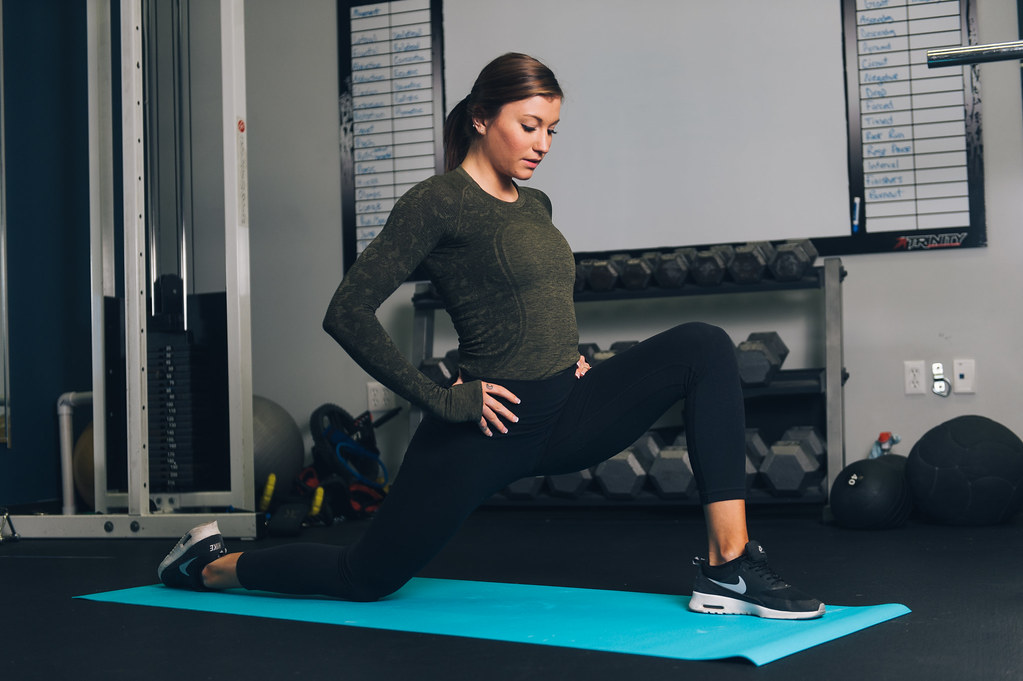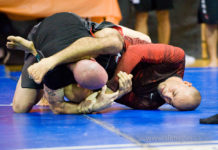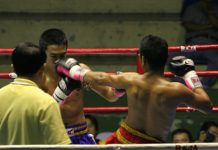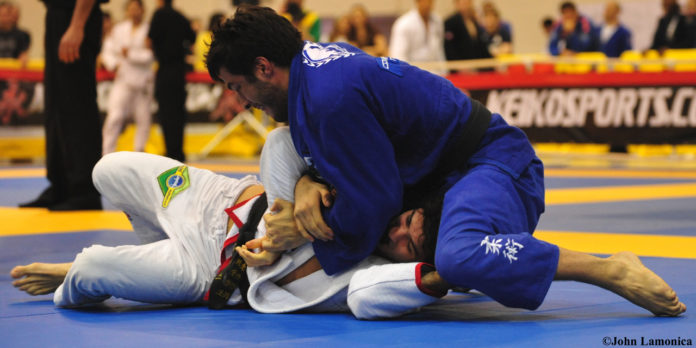Featured Image: Lucas Lepri vs Roger Gracie by John Lamonica. Licensed under CC BY-SA 3.0.
You probably often hear that BJJ is a martial art requiring no athleticism, strength, or flexibility to be effective. BJJ can certainly be used to offset the athleticism of an opponent by superior technique.
Nevertheless, improving your flexibility for BJJ can drastically improve your game while reducing your risk of injury.
In the following article, we break down the benefits of flexibility for BJJ and discuss five stretches you can use to improve your BJJ flexibility.
At the end, I’ll give you a sneak peek at my favorite BJJ stretching instructional course if you are looking for a more comprehensive stretching program for BJJ.
The Benefits of Flexibility for BJJ
The general benefits of flexibility for BJJ fall primarily into two main categories. Specifically:
- preventing or reducing injuries
- improving performance
Depending on your specific goals in BJJ and your current flexibility levels, you may need to spend more or less time stretching. Regardless, the stretches in this program and the benefits of following a BJJ stretching routine cannot be understated.
Preventing or Reducing Injuries
Making dramatic claims about the benefits of flexibility BJJ is difficult without doing specific experimental research on BJJ athletes following flexibility programs. Nevertheless, research suggests that in general, better flexibility reduces the overall risk of injury.
When looking at the science, it’s important to understand that strength and conditioning research is very sport-specific. Certain sports will benefit more from flexibility, and in other cases, excessive flexibility may be detrimental to performance.
From a general standpoint, it is well documented that certain restrictions and tight muscles can increase injury risk during functional movements. For example, during squatting movements, tight adductors (inner thigh muscles) can lead to caving of the knees and increased risk of ACL injury. Flexibility training is one of the tools used to offset and counter these risks.
Given that BJJ requires a variety of ‘abnormal’ body positions and coordination with large range of motion movements, its not unreasonable to assume that excessive muscular tightness could lead to injury given the extreme positions often required in BJJ.
If a muscle lacks the flexibility to reach a certain range of motion, the pressure and tension is transferred directly to the tendons and connective tissues, which are more susceptible to injury. If the muscle can stretch enough to reach the position without putting stress on the joint itself, you risk of injury will decrease.
Improving BJJ Performance with Stretching
You cannot deny the advantage of having more moves and positions in your BJJ arsenal. If you have the flexibility to reach certain positions, you have more options when it comes to defense and offense.
The classic example is the guard players with gumby legs. You know, the guy or gal who somehow weasels their foot back in despite your *almost* passing their guard… its frustrating right?
Compared to someone who lacks the flexibility to touch their toes, the gumby guard player will have a more difficult-to-pass guard.
Of course, this does not negate the need for good technique, however it does give some advantage to the more flexible player.
The degree to which ‘more flexibility’ helps your BJJ depends heavily on the paths, positions, and submissions you favor. There are many successful BJJ black belts who do not have spaghetti-like limb flexibility. Nevertheless, if you tend to be tight overall, as many of us do, a regular stretching routine will most likely help your BJJ game.
The Best Stretching Routine for BJJ

Source: thoroughlyreviewed.com
Stretching is far from a one-size-fits-all category of training. You have static and dynamic stretches, foam rolling, and other techniques for improving range of motion, mobility, and flexibility.
In this routine, we specifically focus on static stretches you can perform with limited or no equipment as a separate training session from your normal BJJ class.
Your best bet is to perform these stretches either after your BJJ class, or as a separate session preceded by 5 to 10 minutes of light aerobic activity such as brisk walking, jogging, or even solo BJJ drills.
Ideally, performing this routine after every practice will yield the best results. However, even just two stretching sessions per week will deliver great results.
Lying Hamstring Stretch
This classic hamstring stretch improves your ability to flex your hip and can help improve the dexterity of your legs. You can perform the stretch with a strap or even an old BJJ belt (ideally *not* with your current belt). Perform 2 to 3 sets per leg.
- Lie on the floor on your back with both legs extended. Gently flex your feet with your toes pointing up.
- Gently bring one knee up and then straighten your leg out. Raise the straightened leg until you feel a stretch in your hamstring. If you have a strap or a BJJ belt, you can wrap in around your foot for extra support. Otherwise, use your hands on the back of your leg to keep it elevated.
- Make sure your back stays flat or neutral against the floor. Do not allow the low back to arch.
- Hold the stretch for 30 seconds.
Check out the demonstration below:
Lunge Stretch
This lunge stretch variation will open up your hip flexors, which tend to get tight from both excessive sitting and BJJ training itself. Perform 2 to 3 sets per leg.
- Start in a lunge position. Let your back knee rest gently on the ground with the top of your foot flat on the floor.
- Reach up with your arm on the same side as your knee-down leg. Maintain a neutral spine and avoid leaning forward with the torso.
- Gently shift your hips forward to feel a stretch the front of your hip on the knee-down leg.
- To increase the intensity, you can reach back for your foot with the arm on the front-leg side.
- Hold for 30 seconds and repeat 2-3 times on each hip.
Demonstration:
Crossover Glute Stretch
This classic hip and glute stretch is a must-do for improving your guard and ability to weave with your legs.
- Begin on your back with both knees up.
- Raise one leg and cross that same ankle over your opposite thigh.
- Gently raise the non-crossed leg until you feel a stretch in the back and side of your hip.
- Hold for 30 seconds. Repeat 1-3 times on each side.
Bretzel
The Bretzel is a stretch from the famed Functional Movement System curriculum that opens your back and hips in the same stretch.
- Start lying on your back with your legs straight.
- Bend one knee and cross it over the other leg.
- Bend the other knee and bring your foot towards your hip.
- Reach for your bottom foot with your hand. Grip the top of your hamstring on the top leg with your other hand.
- Work to keep your upper back flat. You will feel a stretch in your legs and through the mid-back.
- Hold for 30 seconds and repeat on both sides for 1-3 sets.
The Prayer Stretch
The prayer stretch is an amazing technique to loosen up your shoulders, lats, and T-spine area. Perform 2 to 3 sets.
- Start on all fours with a chair or bench in front of you.
- Place your hands together and position your elbows on the edge of the chair.
- Gently drop your head between your arms and sink your chest towards the floor.
- Hold the stretch for 20-30 seconds.
The Best BJJ Stretching Courses
I believe you can make excellent progress stretching for Jiu Jitsu on your own.
However, if you do want a more in-depth stretch course for BJJ, I recommend the Kinstretch for Jiu Jitsu courses from Hidden Jiu Jitsu.
These courses are split into stretching for upper extremities and stretching for lower extremities.
Each course covers techniques such as controlled articular rotations, retractions stretching, and other more advanced stretching techniques.
Stretching for Jiu Jitsu is a must, and if these courses help keep you consistent and give you the information you need to stay flexible, healthy, and injury-free for BJJ, then its an investment well worth making.
Check out:
The Bottom Line: Flexibility for BJJ
Flexibility training is another tool in your box for improving your BJJ and reducing injury risk.
Stretching alone without investing in BJJ training itself will not make you better at BJJ. However, adding flexibility training to your overall program will pay dividends in the long run as your technique arsenal expands and your injury rate declines.





